공지사항
-
- '노란봉투'캠페인/국제연대..
- no chr.!
173개의 게시물을 찾았습니다.
..CHUN-HUA DONGJI ^^
In the beginning of last year Chun-hua, a Chinese female migrant worker from Harbin was working together with us in MWTV.
In March 2005 I made with her reports about two anti-war rallies and demonstrations in Seoul. Actually the cooperation with her was very funny, because she didn't speak not even one word English and understood nearly nothing what I said in English. I wasn't able to speak Korean(only a kind of gibberish..^^), I only understood a little from her, even her Korean was excellent, like her Chinese... Harrharr, but my Chinese.. ^^
But we had also to make several interviews with Korean demonstrators/audience.. And, except only one Korean activist, nobody else understood my English.. So you can imagine that to make interviews, I prepared questions before to start the work, was a "little difficult". But finally we made it.. and in my opinion - it was our first TV report - the result wasn't soo bad(??).
You can watch our contribution here (3.19/20 反戰 報告/anti-war demo report, you can see it at the end of the first third of the show).
PS: I remember very well this evening when we made this recording.. we hade to practice to use the camera and to make/record an announcement.. And it was getting dark but still it was f.. noisy(traffic..)^^
Sunday, 8.20
4 pm
in Ansan, Gojan Park
According to MWTV the event is beginning at 4 pm, but according to the poster: 12 am.
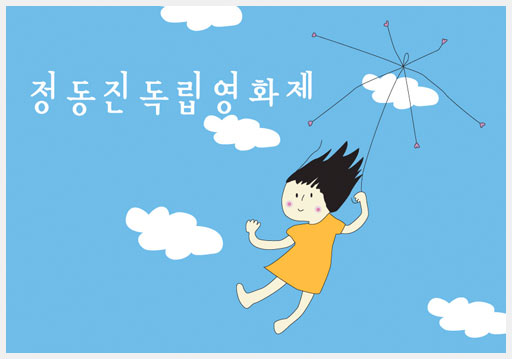
Oops.. instead of three hours I needed THREE DAYS.. but here, finally it comes ^^:
Already nearly 5 years ago, during and short after PIFF 2001(this was my 1st time in S.K.), I heard first time about Jeongdongjin Independent Film&Video Festival(jiff). At that time a jiff activist indeed adored about the next festival in the coming year(2002) and because of this, especially because of her(the activist’s) impressive and beautiful ideas for the event, I decided that I really MUST participate at this event.
So when I came the third time to S.K. – during the second time, I was staying about three month there, I got no possibility to contact the jiff activist – I decided to go alone to the coming jiff. But just coincidentally at that time the activist contacted me and we went together to jiff.
Actually - haha, like every year – jiff 2002 (http://jiff.co.kr/2005/page34.php) was held during the typhoon season. And the typhoon season at the East Sea, where Jeongdongjin is located, is really f.. strange. So when we arrived at the place where jiff should be held(a middle school in the small town of Jeongdongjin) the school yard was complete under water, just like a swamp.
And the activists already were on the way to prepare the open air screening, planned for two days later.
And here started the crazy, but very impressive story. For the air screen there must be a stabilization and it must be filled with water. So the organizers called the Jeongdongjin fire brigade to bring water. Harr, and because also S.K. is a service society the fire brigade came with a big truck with water. But the school yard, as I said before, was already a huge swamp. And the truck... sunk at least a half meter in the ground of the school yard. At next the organizers had to call a construction company to bring a crane to pull out the fire brigade truck. After the truck was out we had to order thousands of Kilogramm of new sand to fill out the huge holes, the fire brigade truck left over..
So finally we had many hours of really hard work for to prepare the air screen. And the next afternoon, after all damages were repaired, the air screen got holes, or whatever, and losed the air. Harrharr... many hours of f.. hard work and finally...
Anyway at that night, during the late afternoon guests(mainly movie freaks/directors/activists/ organizers..) especially from Seoul arrived, we’d a great opening party.. (with at least two hundred bottles of soju for about max. 40 people..)
The film festvival itself I could join, because of some "personal problems" I was forced to go back at the next day to Seoul.
But anyway.. this was one of my most impressive experiences I had until that time. Actually I’ll never forget this and many times I thought that it would be really great to make a (short) movie about this weekend in Jeongdongjin... (possibly a "tragic comedy"^^)
Well, I made, when I remember well, a lot of photos about this "two days of struggle with nature and technology" and somewhere in Seoul they must be still exist..??!!
Aeh~~ its just MY memory...
harrrrr~~~ it seems that I'm some days to late^^
More about it a short while(about three hours) later..
Thanx for your patience!^^
The first present for my today's ..blabla - in advance: last night/this morning the 100,000th person was checking the stuff here on my blog. THANX TO ALL OF YOU!!
Among the possibility for me to return "home"(->南朝鮮!!/aeh~ I know the working class has no "home", i.e. father-/motherland^^) immediately(!!), an adequate alternative blabla present would be the (communist^^, or whatever)revolution as soon as possible, or at least: tear down[blow up, burn down..(*)] today the US embassy(^^)!! THANX IN ADVANCE!.
(*)
7월 12일 보도자료
7월 12일(水)
10:00 한미FTA저지 결의대회(신라호텔 앞)
14:00 부문대회
16:00 2차 범국민대회(광화문)
SMASH CAPITALISM!!
자본주의 박살내자!
Right now, but one year ago, we - dozens of migrant worker activists, our Korean supporters and MWTV staff(..me^^) - were sitting in a restaurant near Kyobo B/D, in the center of Seoul, after we finished two rallies/demonstrations.
The first event was, in the early afternoon, the MTU(Migrant Workers Trade Union) rally in Myeong-dong where hundreds of migrants, Korean workers and students protested against the ongoing policy of manhunt and mass-deportation by the S. Korean govt against migrant workers in general and against the kidnapping and imprisonment, in the month before, of Anwar Hossein("Anwar-wiweonjang"), the chairperson of MTU.
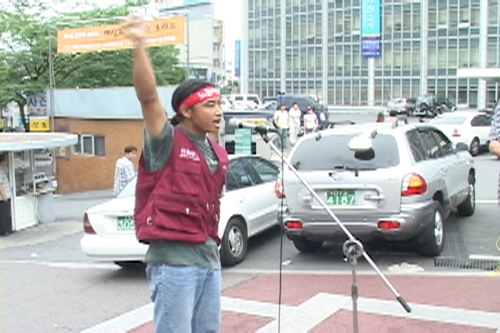
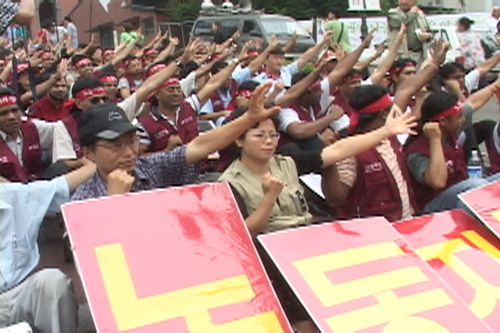

About two hours later or so we joined the anti-war rally in Daehak-no and the following demonstration to Gwanghwamun, downtown Seoul, aimed on one side against the collaboration of S. Korean troops in the ongoing war in Iraq. On the other side the rally/demo should remember the death of the S. Korean citizen Kim Seon-il who was kidnapped and later beheaded by Al Qaeda in Iraq one year ago(2004). Ha, here one of our representative, who held the speech on the opening rally called Kim Seon-il a S. Korean "migrant worker" in Iraq...^^ Btw.. on this rally/demo, when I remember well, much more people participated as on the event what was held two days ago(6.24) in Seoul..

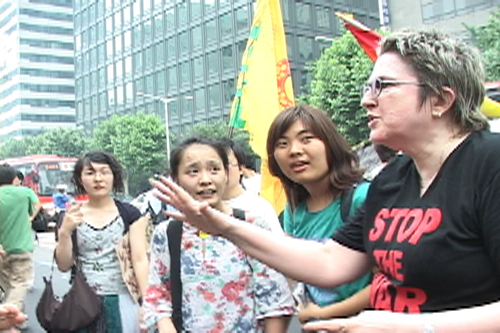
Actually both rallies/demos were the last of such events I was able to join in S. Korea..
And it was also the last time for me that I was sitting together with many of my comrades to have a kind of after-demo-"party".
uhuu.. it's very strange for me to remember.. I miss everything..
More pictures about both demos you can see here:
http://blog.jinbo.net/CINA/?pid=207
http://blog.jinbo.net/CINA/?pid=209
Here:
in MWTV 4th edition(in the first third of the entire broadcasting) you can watch some of my (video) shots I did during this events. But actually I wasn't able to edit the stuff/complete my planned documentary.. and so you see mainly stuff what I never wanted to use..
IHT, NYT published yesterday following STUFF..
China's brand: Pictures of Mao
Few images created in the last century are as recognizable as the official portrait of Mao Zedong that looms over Tiananmen Square in Beijing.
For decades, the 4.5-by-6 meter, or 15-by-20-foot, oil painting has served as a national icon. This is the same image that, in the 1960s and 70s, was widely reproduced and hung near the entrances to millions of homes, schools, factories and government buildings.
During the Cultural Revolution, when Mao was raised to cult status, it seemed as if the entire nation had set about drawing a Mao portrait, or at least honoring one. If Mao's Little Red Book was the national bible, Mao's official portrait was the national stamp.
And while people in China seem to have lost some affection for Mao, and even protested in 1989 by splattering his Tiananmen portrait with paint, his image still represents something indelible and intangible, experts say.
"This is the most important painting in China," said Professor Wu Hung, an art historian at the University of Chicago. "This is not an artistic judgment. But look at how many people have seen this image over the last century."
Mao's image may also be considered the first and only Chinese global brand. Even though China is a rising economic power, it still does not have a BMW or a Coca-Cola to sell to the rest of the world.
But it does have Mao - a kind of George Washington, James Dean and Che Guevara wrapped in one; a historic and pop figure who continues to be hip and fashionable, even when communism and the Communist Party are not.
And so it is no surprise that a firestorm erupted in China a little over a week ago after a state-controlled Beijing auction house wheeled out an old official portrait of Mao, owned by a Chinese-American, and said it would sell the piece to the highest bidder on June 3.
Huachen Auction said the small portrait, dating from the 1950s or '60s, was painted by Zhang Zhenshi, one of first official portrait makers of Mao and the artist credited with the model for the painting that hangs in Tiananmen Square.
After critics on the Internet in China lashed out at the planned sale, Huachen withdrew the item, saying the government had intervened and "suggested" the work be placed in a national museum.
But the controversy raised some intriguing questions. Who actually painted Mao's official portrait? And why is it still up in the square, when many Chinese seem more eager to buy Gucci bags than Mao suits?
Some of the answers can be found in Wu's book "Remaking Beijing," which says Mao's image, like the socialist state, was actually created by committee.
Nor was it the first such portrait to hang in Beijing. A large one of Sun Yat- sen, the founder of the Chinese Republic, was raised in the square after his death in 1925. And the image of Chiang Kai-shek, leader of the Kuomintang, or Nationalists, was hung there in 1945.
Mao's portrait appeared in 1949, after the Communists assumed power. First, a hastily sketched portrait was hung in February of that year.
Then, on Oct. 1, when Mao declared the founding of the People's Republic of China from the rostrum at Tiananmen Gate, an official portrait, based on a photograph, showed Mao wearing an octagonal cap and coarse woolen jacket.
The cap-wearing Mao did not last long. A year later, 30 artists were asked to create a new image, and Zhang, a teacher at the Beijing Art Institute, was named the official portrait maker.
From 1950 to about 1964, Zhang painted Mao's Tiananmen portrait, based on official photographs, often with the help of artists who were supposed to be anonymous.
The portrait evolved over time. Mao in an army cap gave way to Mao's sideways glance, which was replaced by the now standard Mao frontal pose, with his eyes peering directly at viewers. An early piece was criticized because Mao appeared to be looking away from - possibly ignoring - the masses.
Historians say that in the 1950s or 60s, Zhang created the standard image, based on a photograph of Mao in his trademark gray suit. And by 1967, when the Cultural Revolution was under way, a final tweak had been added: The painting showed both of Mao's ears, rather than just one, proof that he was listening to all the people and not just a select few.
The artists, Wu said, were not supposed to be creative, but merely render the image from carefully selected photographs.
"If you emphasized the artist, then it would be a work of art," Wu said. "That was not the intention."
Over the years, the painted Mao has aged, appeared grim, taken on a fatherly look, and even shown a faint smile. At some point, the shadow on his face was reduced.
Since 1949 there have only been four official portrait artists, but many unofficial contributors, like Wang Qizhi, now in his late 70s, who said in an interview last week that he had worked for over 20 years on portraits of Mao, leaving few records.
"The old canvas was reused by putting on white paint to cover the previous painting," Wang said. "One piece of canvas was used five or six times. When it became too thick to paint, people pulled off the canvas and put on a new one."
Apparently, Mao's colorful oil portrait came down only once, briefly, after his death in 1976, when it was replaced by a huge black-and-white photograph, a sign of mourning.
Why has the image not come down since? Some believe that such a move would signal the demise of the party. Others say the portrait is a cultural relic.
"It's a very complex image," said Wu, who grew up near Beijing. "It has different meanings to different people. To the party, it symbolizes the party and the nation's founding. But to a lot of people it symbolizes China, or it has very personal memories."
That is one reason Mao's official image has changed mostly in subtle ways.
Beyond Tiananmen Square, however, artists have experimented more freely, and after Mao's death, some played with his once-sacred image. Wang Keping attracted international attention in 1979 by carving a wooden image of a Buddha-faced Mao called "Idol."
In the 1980s, Wang Guangyi dissected Mao by putting him behind bars, or a large grid. Li Shan put a flower and lipstick on him. Gao Qiang made him look sickly, swimming in a blood-red Yangtze River.
But Mao's defenders are never far behind. Zhang's painting of Mao is no longer up for auction, thanks to government intervention.
And several weeks ago, when Gao's sickly Mao was raised in an exhibition space in the trendy Beijing area of Dashanzi, the police showed up. They had the image removed. Officially, there is still only one Mao, and he is still the national icon.
SHANGHAI Few images created in the last century are as recognizable as the official portrait of Mao Zedong that looms over Tiananmen Square in Beijing.
For decades, the 4.5-by-6 meter, or 15-by-20-foot, oil painting has served as a national icon. This is the same image that, in the 1960s and 70s, was widely reproduced and hung near the entrances to millions of homes, schools, factories and government buildings.
During the Cultural Revolution, when Mao was raised to cult status, it seemed as if the entire nation had set about drawing a Mao portrait, or at least honoring one. If Mao's Little Red Book was the national bible, Mao's official portrait was the national stamp.
And while people in China seem to have lost some affection for Mao, and even protested in 1989 by splattering his Tiananmen portrait with paint, his image still represents something indelible and intangible, experts say.
"This is the most important painting in China," said Professor Wu Hung, an art historian at the University of Chicago. "This is not an artistic judgment. But look at how many people have seen this image over the last century."
Mao's image may also be considered the first and only Chinese global brand. Even though China is a rising economic power, it still does not have a BMW or a Coca-Cola to sell to the rest of the world.
But it does have Mao - a kind of George Washington, James Dean and Che Guevara wrapped in one; a historic and pop figure who continues to be hip and fashionable, even when communism and the Communist Party are not.
And so it is no surprise that a firestorm erupted in China a little over a week ago after a state-controlled Beijing auction house wheeled out an old official portrait of Mao, owned by a Chinese-American, and said it would sell the piece to the highest bidder on June 3.
Huachen Auction said the small portrait, dating from the 1950s or '60s, was painted by Zhang Zhenshi, one of first official portrait makers of Mao and the artist credited with the model for the painting that hangs in Tiananmen Square.
After critics on the Internet in China lashed out at the planned sale, Huachen withdrew the item, saying the government had intervened and "suggested" the work be placed in a national museum.
But the controversy raised some intriguing questions. Who actually painted Mao's official portrait? And why is it still up in the square, when many Chinese seem more eager to buy Gucci bags than Mao suits?
Some of the answers can be found in Wu's book "Remaking Beijing," which says Mao's image, like the socialist state, was actually created by committee.
Nor was it the first such portrait to hang in Beijing. A large one of Sun Yat- sen, the founder of the Chinese Republic, was raised in the square after his death in 1925. And the image of Chiang Kai-shek, leader of the Kuomintang, or Nationalists, was hung there in 1945.
Mao's portrait appeared in 1949, after the Communists assumed power. First, a hastily sketched portrait was hung in February of that year.
Then, on Oct. 1, when Mao declared the founding of the People's Republic of China from the rostrum at Tiananmen Gate, an official portrait, based on a photograph, showed Mao wearing an octagonal cap and coarse woolen jacket.
The cap-wearing Mao did not last long. A year later, 30 artists were asked to create a new image, and Zhang, a teacher at the Beijing Art Institute, was named the official portrait maker.
From 1950 to about 1964, Zhang painted Mao's Tiananmen portrait, based on official photographs, often with the help of artists who were supposed to be anonymous.
The portrait evolved over time. Mao in an army cap gave way to Mao's sideways glance, which was replaced by the now standard Mao frontal pose, with his eyes peering directly at viewers. An early piece was criticized because Mao appeared to be looking away from - possibly ignoring - the masses.
Historians say that in the 1950s or 60s, Zhang created the standard image, based on a photograph of Mao in his trademark gray suit. And by 1967, when the Cultural Revolution was under way, a final tweak had been added: The painting showed both of Mao's ears, rather than just one, proof that he was listening to all the people and not just a select few.
The artists, Wu said, were not supposed to be creative, but merely render the image from carefully selected photographs.
"If you emphasized the artist, then it would be a work of art," Wu said. "That was not the intention."
Over the years, the painted Mao has aged, appeared grim, taken on a fatherly look, and even shown a faint smile. At some point, the shadow on his face was reduced.
Since 1949 there have only been four official portrait artists, but many unofficial contributors, like Wang Qizhi, now in his late 70s, who said in an interview last week that he had worked for over 20 years on portraits of Mao, leaving few records.
"The old canvas was reused by putting on white paint to cover the previous painting," Wang said. "One piece of canvas was used five or six times. When it became too thick to paint, people pulled off the canvas and put on a new one."
Apparently, Mao's colorful oil portrait came down only once, briefly, after his death in 1976, when it was replaced by a huge black-and-white photograph, a sign of mourning.
Why has the image not come down since? Some believe that such a move would signal the demise of the party. Others say the portrait is a cultural relic.
"It's a very complex image," said Wu, who grew up near Beijing. "It has different meanings to different people. To the party, it symbolizes the party and the nation's founding. But to a lot of people it symbolizes China, or it has very personal memories."
That is one reason Mao's official image has changed mostly in subtle ways.
Beyond Tiananmen Square, however, artists have experimented more freely, and after Mao's death, some played with his once-sacred image. Wang Keping attracted international attention in 1979 by carving a wooden image of a Buddha-faced Mao called "Idol."
In the 1980s, Wang Guangyi dissected Mao by putting him behind bars, or a large grid. Li Shan put a flower and lipstick on him. Gao Qiang made him look sickly, swimming in a blood-red Yangtze River.
But Mao's defenders are never far behind. Zhang's painting of Mao is no longer up for auction, thanks to government intervention.
And several weeks ago, when Gao's sickly Mao was raised in an exhibition space in the trendy Beijing area of Dashanzi, the police showed up. They had the image removed. Officially, there is still only one Mao, and he is still the national icon.
http://www.iht.com/articles/2006/05/28/news/mao.php

Don.t believe the enemy!!
But if you want to fight your
enemy, you must study him, her...
REVOLUTIONARY 1st of MAY, THE INTERNATIONAL STRUGGLE DAY
OF THE WORKING CLASS
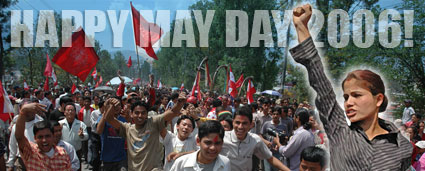
by GEFONT
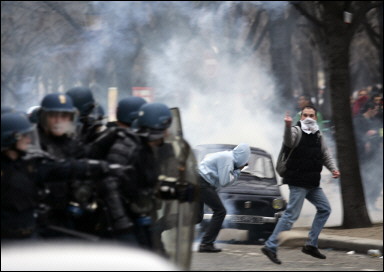
LETS FIGHT TOGETHER FOR A WORLD
WITHOUT EXPLOITATION AND OPPRESSION!!
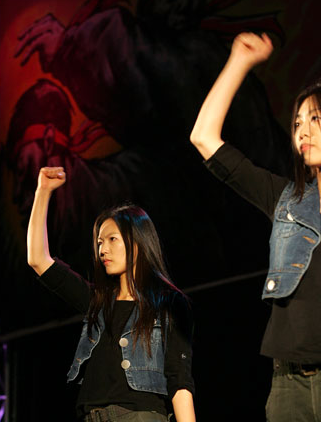
투쟁!
Actually, like in Seoul, there was nothing really to report... 700 or 1000 demonstrators... thats all... Palestinian Islamists, Turkish Maoists, several so called Communist Parties of Germany, Iranian Monarchists, three different German Trotskyists groups...
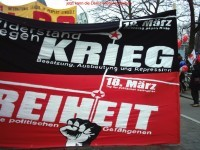
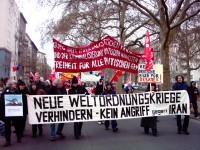
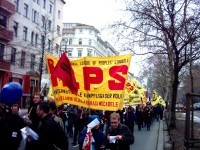

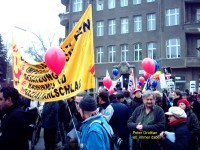
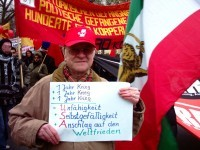
1 year war
1 year war
1 year war
----------
Inability
Self obligingly
Attack against the world peace
.
.
.
.
.
...but where we can find world peace......... NOWHERE!!!
Well, just forget it!!!
덧글 목록
관리 메뉴
본문
Happy birthday. I hope you are able to get home soon.부가 정보